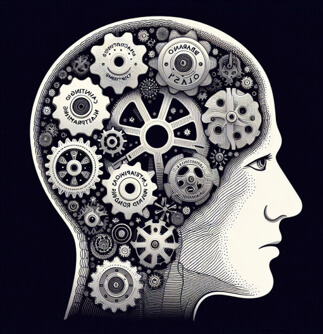
Have you ever walked out of a job interview convinced you bombed it, only to later find out you nailed it? Or perhaps you were sure your presentation was a disaster, but received rave reviews? These experiences highlight a common phenomenon: cognitive distortions. These mental missteps can lead to negative thinking, but recognizing and addressing them can make a world of difference.
What Are Cognitive Distortions?
Cognitive distortions are exaggerated or irrational thought patterns that can trick us into viewing situations more negatively than they are. These distortions are our mind’s way of convincing us of things that aren’t necessarily true. They can deeply influence our emotions and behaviors, often leading us to act on faulty assumptions.
We all experience cognitive distortions from time to time, especially when when feeling discouraged. However, frequent engagement in these negative thought patterns can take a toll on our relationships and mental health. Learning to identify these distortions is crucial to reversing their impact through effective problem-solving.
Common Cognitive Distortions
There are many types of cognitive distortions. Here are a few common ones:
- Filtering: This involves focusing solely on the negative aspects of a situation, ignoring the positives.
- Example: After receiving mostly positive feedback in a performance review, you dwell on one minor suggestion for improvement.
- Polarization (All-or-Nothing Thinking): Viewing situations in black-and-white terms, with no middle ground.
- Example: Believing you’re a failure because you received a B on a test, despite consistently getting A’s.
- Overgeneralization: Turning a single negative event into a never-ending pattern of defeat.
- Example: Thinking, “I never say the right thing!” after one unsuccessful suggestion in a meeting.
- Discounting the Positive: Rejecting positive experiences by insisting they don’t count.
- Example: Thinking someone complimented your work just to be nice, not because it’s actually good.
- Jumping to Conclusions: Making negative assumptions without evidence.
- Example: Assuming your partner is mad at you because they look serious, when in fact they had a bad day at work.
- Catastrophizing: Expecting the worst-case scenario in every situation.
- Example: Thinking, “What if I get fired for being late?” after hitting a red light.
- Personalization: Blaming yourself for events outside your control.
- Example: Believing you’re responsible for a friend’s bad mood.
- Control Fallacies: Believing you have total control over everything, or no control at all.
- Example: Thinking your boss’s overwork schedule is why you couldn’t complete a report.
- Fallacy of Fairness: Believing everything must be fair, according to your standards.
- Example: Expecting a partner to massage your feet because you made dinner, despite their own needs.
- Blaming: Holding others responsible for your emotions.
- Example: Telling your partner, “You made me feel bad about myself.”
- “Should” Statements: Having rigid rules for yourself and others.
- Example: Thinking, “I should never ask for help,” and feeling guilty when you do.
- Emotional Reasoning: Believing that your feelings reflect reality.
- Example: Thinking, “I feel anxious, so something bad will happen.”
- Fallacy of Change: Expecting others to change to meet your expectations.
- Example: Expecting a partner to become a homebody for your sake.
- Global Labeling: Assigning broad, negative labels based on a single event.
- Example: Calling yourself “useless” after one mistake.
- Always Being Right: Insisting on being right, regardless of evidence or others’ feelings.
- Example: Arguing with a sibling about parental support to prove your point.
Overcoming Cognitive Distortions
Most irrational thought patterns can be reversed once we recognize them. Here are some strategies:
- Think About Your Thoughts: Reflect on what you’re telling yourself about an upsetting event.
- Replace Absolutes: Use words like “sometimes” instead of “always” or “never.”
- Label Behaviors, Not People: Describe actions instead of assigning labels.
- Find Positives: Identify at least three positive aspects in each situation.
- Seek Evidence: Ensure your conclusions are backed by facts, not assumptions.
Cognitive distortions can cloud our judgment and affect our emotions. They also can cause us to ascribe meaning or intent in someone else’s words or actions that was never intended. By identifying and reframing these negative thoughts, we can improve our mental well-being and lead a more positive, fulfilling life. We also can more astutely hear and process the words, needs, and actions of others, which then allow us to calmly discuss and respond with out rational brain
We at Herd Dispute Resolution, LLC, utilize these principles as we discuss issues and facts with parties and their counsel, testing beliefs, asking probing questions, and considering various solutions that will help lead to resolution of the matter in dispute.
6/21/2024
Read more about how to handle cognitive distortions here and here.
Other References:
Beck, A. T. (1976). Cognitive therapies and emotional disorders. New York: New American Library. Burns, D. D. (1980). Feeling good: The new mood therapy. New York: New American Library.




